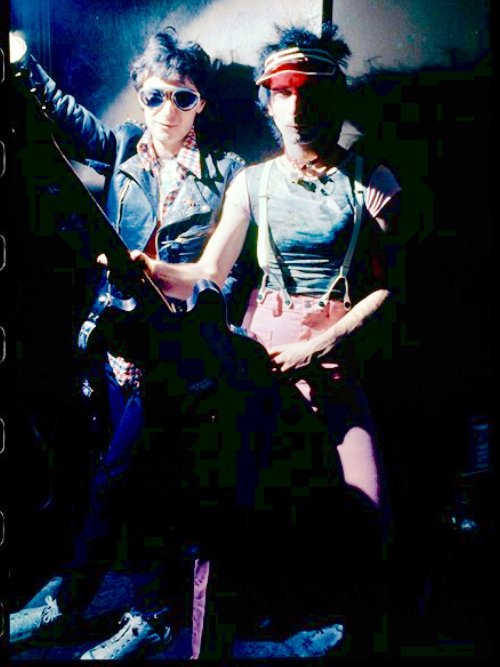Art designer Arturo Vega, aka “the fifth Ramone” (best known for having created the band’s iconic lo
Art designer Arturo Vega, aka “the fifth Ramone” (best known for having created the band’s iconic logo, their ‘leather jacket/ripped jeans’ look, posters, tees and album covers) and Miki Zone of glam punk band The Fast, already a headlining act of the Max’s/CBGB scene by the mid-’70s, as captured by Chris Stein of Blondie at Max’s Kansas City in NY ca. 1975-76.“For every hitmaker that emerged from the mid-1970s New York punk scene, like Blondie or Talking Heads, there were several more obscure groups like The Fast. Well, actually, no one was quite like The Fast. This is the story of three brothers — Miki, Mandy and Paul Zone — who grew up bisexual in a working-class Brooklyn neighborhood, then became Zelig-like figures within the 1970s glam rock and punk movements.“As long as I remember coming of age,” Paul said, “Miki was already playing guitar.” Beginning in the mid 1960s, Miki immersed himself in music magazines, collected records, practiced his guitar and developed an unusual fashion sense. Mandy — the middle child — followed his brother’s lead, joining in on vocals. Paul helped out by sewing costumes, designing stage props and running lights and sound for his older brothers. “It was probably 1970,” Paul recalled. “They would play at some battle of the bands or high school dances and block parties — and things like that.”The Fast was certainly not your average suburban high school band. “We had a girl dressed as Alice in Wonderland, and four other girls dressed as nuns with ripped stockings and crazy makeup handing out cookies. They also incorporated glitter, giant candy canes and strobe lights into their shows. A couple years before David Bowie brought the glam aesthetic into the mainstream, the Zone brothers had already been there, done that.“At 13 or 14 — even in eighth grade and ninth grade — I was already wearing clothes that were just completely not accepted in a Brooklyn suburban neighborhood,” he said. “I had platform shoes on. I was wearing satin pants.” Perhaps the oddest part of this strange story is how normal it all seemed to their mom and everyone else in their household. The kids were just being artists, and that was that. “Of course,” he added, “we learned very quickly that what we were doing and how we looked was not meshing very good in Brooklyn. It wasn’t working out, believe me. The band definitely never won the battle of the bands.”Around 1971, the Zone brothers began leaving Brooklyn in the evening and roaming the streets of lower Manhattan — where they eventually made their way into the inner sanctum of downtown cool: Max’s Kansas City. It was a restaurant-bar where the Velvet Underground played their final shows with Lou Reed, future Blondie vocalist Debbie Harry worked as a waitress and bohemian debauchery prevailed. Max’s infamous back room served as a hangout for downtown artists, writers, musicians, underground theater freaks and Warhol’s “superstars.” There, the three brothers crossed paths with the likes of Iggy Pop, Lou Reed, Alice Cooper and the New York Dolls. Paul Zone eventually became Max’s house DJ, sharing record-spinning duties with glam-punk pioneer Wayne County (now Jayne County). Soon after Paul joined The Fast in 1976 as lead vocalist, they became one of the most popular bands on the punk scene — playing their catchy brand of power pop with the Ramones, Suicide, Blondie and other luminaries…”littlevillagemag.com/(via) -- source link
#arturo vega#the ramones#miki zone#the fast#punk rock#glam punk#power pop#chris stein#people

